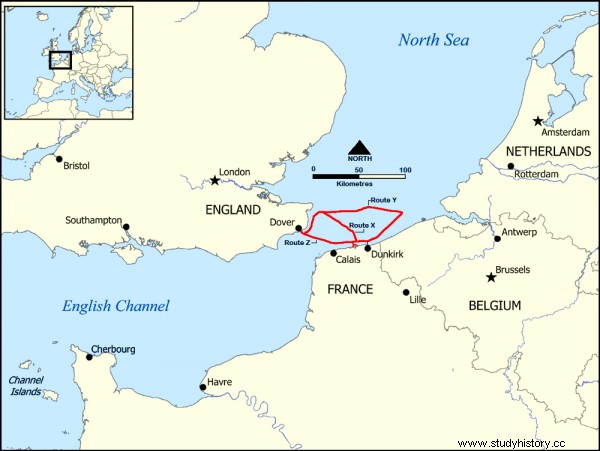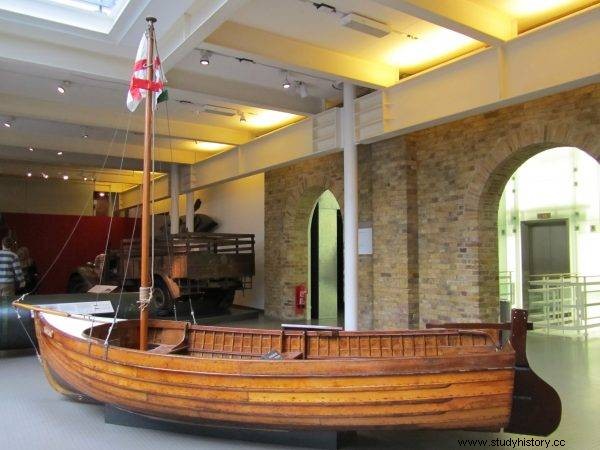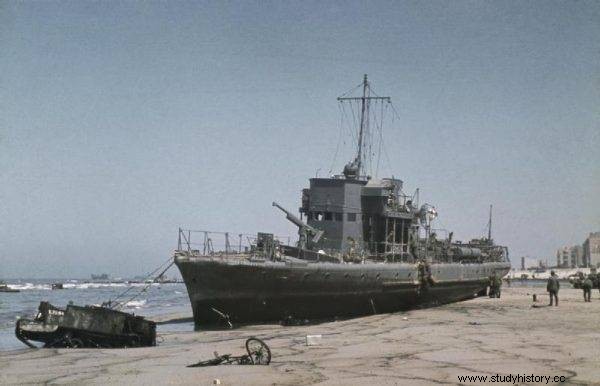May 1940. Germany is pushing west. France is falling. The British were left with a scrap of land. Evacuation becomes necessary. Paradoxically, Adolf Hitler helped in it!
This evacuation might not have happened at all, if not for a very fortunate combination of circumstances. First things first. The German blitzkrieg also went on the Western Front. French forces were crushed. The rapid advances of the Wehrmacht saw the British Expeditionary Force, the 1st French Army and Belgian troops cut off in a small patch of land between Calais and Ostend. Almost half a million soldiers in total.
Escape Plan
The German armored forces seemed unstoppable. They kept advancing, narrowing the area where the Allies could safely stay. They quickly reached the coast of the English Channel and began cutting off more cities. And so on May 22, German troops under the command of General Heinz Guderian (the same, who had previously been disturbed by Captain Władysław Raginis at Wizna, before he heroically died) began to occupy Boulogne and surrounded Calais. The Allies were running out of ports from which they could try to evacuate. In fact, only one remained:Dunkirk. The English started thinking about evacuation a few days earlier. On May 19, 1940, General Gort (actually John Vereker) handed over to the British Minister of War Sir Anthony Eden the evacuation plans Expeditionary Corps.

the map shows the general location of the three shipping lanes used during the Dunkirk evacuation (1940).
So only Dunkirk remained. It was well known not only in London. The German commanders were also aware of this. In order to further strengthen the impact of the strike and hunt down fleeing enemies even faster, Guderian's troops received an additional boost. General Ewald von Kleist gave him one armored division. However, it was not directed to Dunkirk, but to Calais, from where Guderian took another, much stronger division. For it was the attack on Dunkirk that was a priority for him, not the capture of Calais. (Which was a matter of time anyway.)
Unexpected help
On May 23, the Germans saw signposts stating that they had only 25 kilometers to travel. The SS Leibstandarte Adolf Hitler regiment was additionally thrown into the attack. Guderian also recalled reserves from Boulogne. A few more hours and he'll be able to deliver the final blow! But then, on May 24, the "right" Adolf Hitler with a personal order orders ... to stop the attack immediately. Protests are useless.
Why did this happen? In the order there was a mention that the Luftwaffe was to take care of the rest ... In which, of course, she later "failed". Was Hermann Göring then consumed by excessive ambition? Was he so eager to be the one to take the final blow? Or maybe Hitler himself wanted to leave a door for later talks with the British? We will probably never know that again.
Read also:The raid that was supposed to break Great Britain
Inverted D-Day
This is the definition of operation "Dynamo" in a book by Craig Symonds. Anyway, both operations have one more element in common: the person of Admiral Bertram "Bertie" Ramsay who organized the activities. In the case of Dynamo, the loading was coordinated by Commander William George Tennant, to whom Ramsay announced that every man and rifle saved by his ships would be useful for the defense of Great Britain. All ships and ships that could be used for evacuation had to be assembled. Destroyers were brought as far as Norway. An "armada" was assembled, consisting of 39 destroyers, 36 minesweepers, 34 tugs, as well as 113 freighter and trawlers. Additionally, passenger, hospital and fishing vessels. In short - everything that could take soldiers from there.
First, the British thought about the evacuation of their Expeditionary Corps. The French who boarded the ships were ordered to abandon them . It was only later that Winston Churchill decided that the French were to be treated as equal to the British.
Rescue fleet
The evacuation from Dunkirk was a risky logistical undertaking. The Luftwaffe failed to cope with the Allied troops, but destroyed the port infrastructure sufficiently. Attempting to enter the port by transporters ended up sinking one and seriously damaging the other. This meant that soldiers also had to be taken directly from the beach. But due to its shape, destroyers could not get closer than 600 meters . How were the "passengers" supposed to get on board? Small boats. This was a source of conflict and drama as everyone wanted to go and no one would come down when the boat was already overloaded. And then I had to climb the rope ladders on board…

British fishing boat Tamzine used in Operation Dynamo
Later, Dutch barges called schuitjes were added. Still too little and too slow. So all the vessels they could were brought to the site, including the yachts of the Royal Ocean Racing Club. Ba! Even boats on the Thames !
Another scene of the drama was the pier near one of the breakwaters where the soldiers waited for evacuation. Once you stepped onto this pier, there was no turning back. Only hours of waiting in line with continuous fire. It just took nerves of steel! Even getting on board was no guarantee of safety. The fully loaded destroyer HMS Wakeful sank after being hit by a torpedo. Most of the crew and 639 soldiers died. Only one survived.
Balance of the operation "Dynamo"
The entire operation to evacuate British and French soldiers lasted from May 26 to June 4, actually until 3. On the night of June 2-3, the British rear guard, with a total of about 4,000 soldiers, escaped from Dunkirk. 265 badly injured British remained, who could not be taken. A total of 338,226 people were evacuated, including 123,095 French . Some 40,000 were left behind. About 220,000 more troops were later taken from Cherbourg, Saint-Malo, Saint-Nazaire and Brest. About 560,000 in total. But does Dynamo deserve to be called the "miracle of Dunkirk"? As Churchill aptly commented, wars are not won through evacuations.

Equipment abandoned by the Allies on the beach in Dunkirk, 4 June 1940
In total, 848 different types of vessels participated in the entire operation. 235 of them never returned. The navies of both Great Britain and France suffered losses. 6 British and 3 French destroyers were sunk. Additionally, 19 were damaged to varying degrees. It is worth mentioning here that 2 Polish destroyers also participated in the operation:Błyskawica and Burza. Unfortunately, Tempest was excluded from the fight at an early stage. On May 24, the ship was hit by two bombs and was sent back for repairs. Blyskawica, which even entered the port of Dunkirk, remained on the battlefield longer. It was tasked with covering British destroyers engaged in evacuation. She was recalled along with modern British ships on May 31, in order to keep the strength for the fray.
Read also:World War II in the air
Abandoned hardware
The greatest impression in the context of the entire evacuation is made by the amount of equipment left by the British and French troops. These were not only the infantry helmets known from the photos, but also the equipment that could make a difference on the battlefield. And which in no way could be taken. There were 2,472 guns, 445 tanks, 120,000 (!) different types of vehicles, 90,000 rifles and tons of ammunition left.
However, many lives were saved then. Many of the evacuated soldiers later contributed to the final victory over Nazi Germany. The paradox of the whole situation is the fact that they owed their lives indirectly to the irrational (?) Decision of Adolf Hitler.
Bibliography:
- N. Cawthorne, The Decisive Battles of World War II , Bellona, Warsaw 2009.
- T. Górski, Polish navy 1939-1959 against the background of European fleets , Pomeranian Branch of the Catholic Association "Civitas Christiana", Gdańsk 2001.
- A. Perepeczko, Operation "Dynamo" , Morskie Publishing House, Gdynia 1966.
- C. Symonds, World War II at Sea. Global History, Znak Horyzont Publishing House, Kraków 2020.
